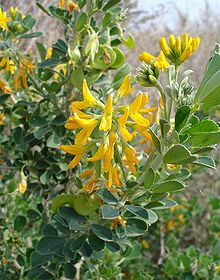Shrub snail clover
| Shrub snail clover | ||||||||||||
|---|---|---|---|---|---|---|---|---|---|---|---|---|

Bush snail clover ( Medicago arborea ) |
||||||||||||
| Systematics | ||||||||||||
|
||||||||||||
| Scientific name | ||||||||||||
| Medicago arborea | ||||||||||||
| L. |
The shrub snail clover ( Medicago arborea ), also called tree snail clover , is a species of the genus snail clover ( Medicago ) in the subfamily of the butterflies (Faboideae).
description
The shrub snail is a woody evergreen plant . It grows as a shrub and is usually 1 to 2 meters high. The compound leaves are threefold.
The flowers are hermaphroditic and 8 to 20 are attached to racemose inflorescences . They smell similar to vanilla or like the sweet pea . A legume wound in a spiral is formed.
The shrub clover is tetraploid with a chromosome number of 2n = 32.
The flowering time in the northern hemisphere falls from May to October.
Distribution and location
The shrub snail is native to Italy , Greece , Albania and Turkey . The shrub snail clover was already widely used as a forage plant in ancient times; today it is a widespread plant in Mediterranean climates around the world.
The plant lives in symbiosis with the root nodule bacteria -type Sinorhizobium meliloti , fixes the nitrogen from the air.
use
The shrub snail clover is grown as a fodder plant in Mediterranean locations. The leaves are eaten raw or cooked in salads, for example. In Central Europe it is occasionally used as an ornamental plant.
Systematics
The first description by the Swedish botanist Carl von Linné was published in 1753. Within the genus, the species is placed in the Dendrotelis section. This section also includes Medicago strasseri Greuter, Matthäs & Risse from Crete and Medicago citrina (Font Quer) Greuter , who is native to small islands in the Balearic Islands .
supporting documents
- ↑ a b M. Rosato, M. Castro, JA Rossello: Relationships of the Woody Medicago Species (Section Dendrotelis) Assessed by Molecular Cytogenetic Analyzes. In: Annals of Botany. Volume 102, No. 1, 2008, pp. 15-22, doi: 10.1093 / aob / mcn055 .
- ↑ Carl von Linné: Species Plantarum. Volume 2, Impensis Laurentii Salvii, Holmiae 1753, p. 778, digitized
further reading
- Edwin T. Bingham: Medicago arborea Project at University of Wisconsin, Madison. In: Medicago Genetic Reports. Volume 5, No. 1, 2005, pp. 1-7, PDF file; 94 kB.
- M. Valdenegro, JM Barea, R. Azcon: Influence of arbuscular-mycorrhizal fungi, Rhizobium meliloti strains and PGPR inoculation on the growth of Medicago arborea used as model legume for re-vegetation and biological reactivation in a semi-arid mediterranean area. In: Plant Growth Regulation. Volume 34, No. 2, pp. 233-240, abstract .
- Aldo Tava, Mariella Mella, Pinarosa Avato, Maria Pia Argentieri, Zbigniew Bialy, Marian Jurzysta: Triterpenoid Glycosides from Leaves of Medicago arborea L. In: Journal of Agricultural and Food Chemistry . Volume 53, No. 26, 2005, pp. 9954-9965, doi: 10.1021 / jf052468x (engl.).
Web links
- Entry for Plants for A Future (Engl.)
- Entry at USDA (Engl.)
- Specifications at ildis.org (Engl.)
- Entry at GRIN.

